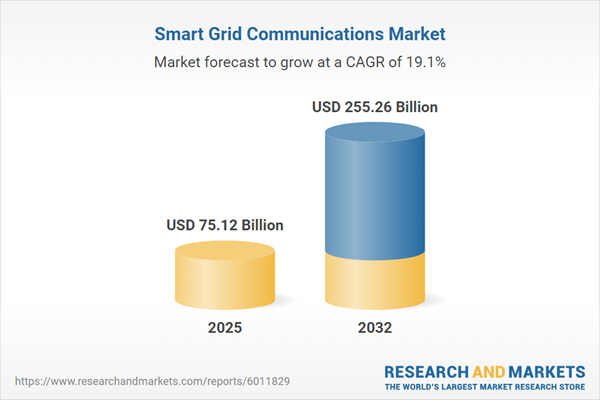Speak directly to the analyst to clarify any post sales queries you may have.
The Smart Grid Communications Market is transforming how utilities manage critical assets, optimize resources, and advance their digital infrastructure. Digital platforms and secure, real-time networks are now central to building adaptive, resilient operations for senior industry leaders.
Market Snapshot: Smart Grid Communications Market Size and Growth Outlook
The Smart Grid Communications Market is projected to grow from USD 62.93 billion in 2024 to USD 75.12 billion by 2025, ultimately reaching USD 255.26 billion by 2032. This expansion highlights a strong compound annual growth rate (CAGR) of 19.12%. The industry's momentum stems from significant digital transformation projects, ongoing investment in critical network infrastructure, and wide-ranging regulatory modernization across established and emerging markets. The sector is experiencing a shift to secure, data-rich communications that empower utilities to enhance operational resilience and adapt quickly to new energy demands and digital protocols.
Scope & Segmentation in the Smart Grid Communications Market
- Components: Communication nodes, gateways, modems, routers, switches, and smart meters all enable seamless grid connectivity and real-time data exchange. Network management tools and integration platforms help utilities achieve centralized oversight and efficient operations.
- Network Types: Home Area Networks (HAN) connect home energy assets using Bluetooth, Wi-Fi, Wi-Sun, and Zigbee technologies. Neighborhood Area Networks (NAN) use Power Line Communication (PLC) and RF Mesh for neighborhood-level smart grid operations. Wide Area Networks (WAN) deploy 5G, fiber optic, and microwave technology for coverage at broader regional scales.
- Communication Technologies: Utilities deploy both wired and wireless networks tailored to compliance requirements, regional landscapes, and enterprise scale for robust and scalable communications throughout infrastructure.
- Applications: The market covers demand response, distribution automation, advanced energy management, electric vehicle charging controls, outage management, and intelligent metering for utility modernization and grid stability.
- End-Users: Customized communication and compliance tools support the diverse requirements of commercial, industrial, and residential sectors, allowing scalable solutions for unique operational strategies and risk profiles.
- Geography: The market spans the Americas, Europe, Middle East & Africa, and Asia-Pacific, each bringing different regulatory frameworks, infrastructure capabilities, and growth trajectories driven by local priorities.
- Key Companies Profiled: Huawei Technologies, Schneider Electric, General Electric, ABB, Itron, Landis+Gyr, Cisco Systems, Ericsson, Sagemcom Energy & Telecom, and Siemens offer comprehensive, adaptable products supporting global and regional smart grid demands.
Key Takeaways
- Utilities are leveraging AI, IoT, and edge computing to gain real-time visibility across assets, enabling earlier risk detection and rapid operational response for improved continuity.
- Flexible network frameworks help utilities navigate evolving policy landscapes and support consistent, uninterrupted operations even in complex regulatory settings.
- Sustained investment in advanced communication systems and governance frameworks is driven by increasing focus on sustainability, with organizations strengthening risk management and compliance efforts across the grid.
- Continuous security and connectivity improvements fortify critical infrastructure resilience, supporting reliable service as market and operational challenges change.
- Regional sourcing strategies and local manufacturing initiatives are reinforcing supply chain stability, reducing lead times and supporting greater responsiveness to disruptions in global supply environments.
- Detailed market segmentation ensures executive teams can strategically align technology deployment and investments with organizational goals, informed by actionable and granular insights.
Tariff Impact: US Measures Shape Supply Chains in Smart Grid Communications
Upcoming US tariffs slated for 2025 are prompting stakeholders in the Smart Grid Communications Market to reconfigure supply chains and prioritize domestic providers. Utilities and technology vendors are adopting regional sourcing approaches to control procurement risks and budgets. The trend toward modular product design is accelerating, giving organizations agility to adapt to shifting trade environments. Increased industry collaboration is now a key strategy, supporting reliable supply chains and operational continuity amid ongoing global trade adjustments.
Methodology & Data Sources
This analysis is grounded in direct interviews with senior industry executives, leading solution providers, and recognized subject matter experts. Every finding is independently validated, ensuring decision-makers have actionable and credible guidance specific to the Smart Grid Communications Market.
Why This Report Matters
- Provides senior leadership with the insights needed to anticipate market risks, address compliance issues, and devise strategies for operational and supply chain complexities.
- Enables informed allocation of resources, targeted investment, and planning by presenting detailed segmentation and in-depth regional trends.
- Supports executives in aligning technology investments and strategic partnerships to achieve compliance, boost resilience, and maintain market competitiveness.
Conclusion
This report delivers the focused market intelligence required to guide digital transformation efforts, help organizations adapt to evolving industry needs, and sustain competitive positioning in the rapidly changing utility landscape.
Additional Product Information:
- Purchase of this report includes 1 year online access with quarterly updates.
- This report can be updated on request. Please contact our Customer Experience team using the Ask a Question widget on our website.
Table of Contents
3. Executive Summary
4. Market Overview
7. Cumulative Impact of Artificial Intelligence 2025
Companies Mentioned
The companies profiled in this Smart Grid Communications market report include:- Huawei Technologies Co., Ltd.
- Schneider Electric SE
- General Electric Company
- ABB Ltd
- Itron, Inc.
- Landis+Gyr AG
- Cisco Systems, Inc.
- Telefonaktiebolaget LM Ericsson (publ)
- Sagemcom Energy & Telecom SAS
- Siemens AG
Table Information
| Report Attribute | Details |
|---|---|
| No. of Pages | 190 |
| Published | October 2025 |
| Forecast Period | 2025 - 2032 |
| Estimated Market Value ( USD | $ 75.12 Billion |
| Forecasted Market Value ( USD | $ 255.26 Billion |
| Compound Annual Growth Rate | 19.1% |
| Regions Covered | Global |
| No. of Companies Mentioned | 11 |









